|
Philadelphia,
Pennsylvania
HOME PAGE
|
Area
Attractions
|
Book History-1st Philly library 1700's
| Montgomery
County | Bucks County | Manayunk | Special
Events |
Dining-MY Restaurant & Bar Picks
Restaurant Guide A-Z
| Shopping | Culture
Events | Hotels | Philly Top 20 List |
Philadelphia,
Pennsylvania
History
Of The City|
Revolutionary
War Tour|
Civil War Tour
|
U. S. History
|
Maps
(Philadelphia)
|
Local Weather |
Local Hotels
Welcome to our Area
Attractions Page! There are a lot of exciting places to visit if you're in town.
I've
indicated some of my
favorite places below, along with a photo and description.
I love to eat and try new places. I've also listed some of MY favorite
restaurants below!
MY
Dining MY Restaurant & Bar Picks
In Blue
Bell Pennsylvania located just outside the city of Philadelphia sits
the Black Horse Inn. ONCE
Threatened by recent developers who would like to tear it
down to build a WALMART; IT HAS NOW
BEEN SAVED!! THANK YOU TO ALL WHO
SIGNED THE PETITION THROUGH
CFSBOOKS.COM'S WEBSITE TO SHOW THEIR SUPPORT TO THIS
HISTORICAL LANDMARK!!-
Black
Horse Inn On Bethlehem Pike WILL REMAIN!!! Please
donate to the project. THEY Need Your Help!
Click here
Many famous individuals
and historical events took place in our area. The signing of the
Declaration Of
Independence, the
battles in the
Civil War, the
battles in the
Civil War,
The
Revolutionary
War, Betsy
Ross, and the Liberty
Bell, Scholarly subjects and much more!!
 During the
Revolutionary war George Washington stayed at the Blue
Bell Inn, (once known as the White House until 1776). The Blue Bell
Inn, now a fine restaurant has a wonderful menu! More information is provided below on the Blue Bell
Inn under our Area Attractions Section. Historical
Valley
Forge Park was also once home for Washington and his troops during the war. During the
Revolutionary war George Washington stayed at the Blue
Bell Inn, (once known as the White House until 1776). The Blue Bell
Inn, now a fine restaurant has a wonderful menu! More information is provided below on the Blue Bell
Inn under our Area Attractions Section. Historical
Valley
Forge Park was also once home for Washington and his troops during the war.
Click photos to
enlarge-Most info. provided by gophila.com
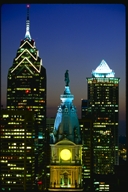
|
Aerial
of William Penn Statue Atop City Hall
The
William Penn Statue, 37 feet tall, is the largest single piece of
sculpture on any building in the world. The statue stands on City Hall
in Philadelphia (built 1871-1901), which is the tallest building ever
constructed without a skeleton of steel girders. Today, Penn is framed
by modern skyscrapers with decorative nighttime lighting. Visitors can
take free tours of City Hall and ride a tower elevator up to the base of
Penn’s feet, where a domed area offers panoramic views of the city and
the surrounding Delaware Valley. Philadelphia boasts the largest city
hall in America. It is located at the intersection of Broad and Market
Streets.
|
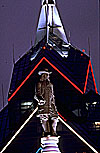 |
William
Penn Statue
William Penn, standing atop the City Hall
Tower, looks over the city he founded in 1682. At 37-feet tall, the
bronze statue, created by Alexander Milne Calder, is the tallest statue
on any building in the world. |
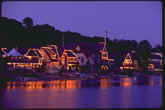 |
Boathouse
Row at Night
Local
boating clubs take great pride in their 19th century boat
houses, which line the Schuylkill River just west of the Philadelphia
Museum of Art. At night, twinkling white lights outline one of the
city’s loveliest views, which has become known as Boathouse Row. This
sculling course at the western edge of Center City is one of the most
popular locations for regattas in the world. It was immortalized by
Philadelphia artist Thomas Eakins. The best views are from the West
River Drive, entering the city.
|
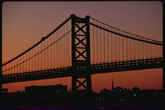 |
Benjamin
Franklin Bridge
A
nighttime view of the Benjamin Franklin Bridge shows its graceful
structure, designed by Paul
Phillipe Cret, Beaux-Arts architect of the
Rodin Museum and other Philadelphia landmarks. The
bridge spans across
the Delaware River, connecting Philadelphia with Camden, New Jersey. It
was
the largest single-span structure in the world when it opened in
1926. From dawn to dusk, visitors
can walk or bicycle across the bridge
and enjoy breathtaking views of the waterfront and river life.
|
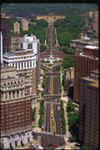 |
View
down Benjamin Franklin Parkway toward Philadelphia Museum of Art
The grand
Benjamin Franklin Parkway was built to connect Fairmount Park with the
center of the city. This gracious boulevard stretches from City Hall to
the Philadelphia Museum of Art (top of photo), and its design was
inspired by the Avenue des Champs-Elysees in Paris. The Parkway is lined
with flowerbeds, trees, fountains, hotels and restaurants. It is home to
many of the city’s large cultural institutions, including The Franklin
Institute Science Museum, the Please Touch Museum,the Rodin Museum , the
Academy of Natural Sciences and the Free Library of Philadelphia.
|
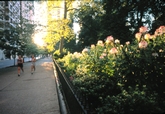 |
Rittenhouse
Square
Families gather in Rittenhouse Square, an
upscale neighborhood in Center City, Philadelphia, featuring trendy
shops, restaurants and galleries, for an afternoon in the park. |
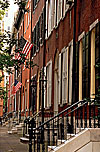 |
Rittenhouse
Square – Delancy Street
Delancy Street is one of the many charming side
streets in the Rittenhouse Square section of Center City, Philadelphia.
A combination of colonial structures and contemporary houses make the
intimate street perfect for a stroll.
|
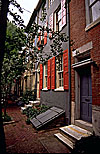 |
Camac
Street
A variety of early 19th-century row
houses occupy Camac Street, America’s only wooden block street. Camac
is also home to two of the country’s oldest artist organizations such
as The Sketch Club and The Plastic Club. |
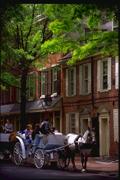 |
Society
Hill by Horse and Buggy
The
charmingly restored, 18th century neighborhood of Society
Hill is perhaps the most visited residential section of Philadelphia.
With its fine mixture of Colonial and Federal style brick row houses,
intimate courtyards and gracious cobblestone streets, Society Hill draws
people on foot and by carriage. The neighborhood stretches from Front
Street west to 8th Street and from Lombard Street to Walnut Street. The
"society" in the name refers to the Free Society of Traders, a
group of colonial businessmen to whom William Penn deeded land to
encourage their economic leadership. Horse-drawn cabs driven by
knowledgeable guides can be hailed in the vicinities of Independence
Mall (4th to 6th on Chestnut Street) and Head
House Square (2nd and Pine Streets).
|
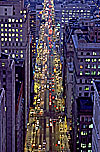 |
Broad
Street – Avenue of the Arts
The Avenue of the Arts, located in the heart of
downtown Philadelphia, is the city’s performing arts district.
World-class theatres, museums, concert halls, and the
soon-to-be-completed Regional Performing Arts Center call the Avenue
home. |
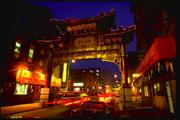 |
Chinatown
in Philadelphia
The
Chinese Friendship Gate, straddling 10th Street just north of
Arch Street, is 40-feet-tall and is the first authentic gate ever
constructed by Chinese artisans outside of China. Building materials,
including special ornamental tile, came all the way from Tianjin, China,
the sister city to Philadelphia. Many of the artisans were from Beijing.
Chinatown is centered at 10th and Race Streets, around the
corner from the Pennsylvania Convention Center. The neighborhood is a
residential and commercial hub for the local Asian community. More than
50 restaurants co-exist with grocery stores, bakeries, souvenir shops,
martial arts studios, and a fortune cookie store.
|
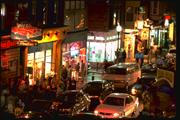 |
South
Street
A
thriving commercial hub since colonial times, South Street has been
reborn many times. Since the 1970s South Street has been an eclectic
shopping and dining area of Philadelphia. From Front Street up through 9th,
one now finds specialty boutiques intermingled with traditional chain
stores and eateries of all kinds. More serious restaurants and
additional shops spill over onto the numbered streets flanking South.
There are several venues for small theater and live music. This
diversity invites an equally diverse crowd to mingle and enjoy the
eccentric and trendy scene, which is especially popular with younger
visitors. Take your teenagers to South Street and you might even get
them to a museum. (They’ll love the Mummer’s Museum at 2nd
and Washington.)
|
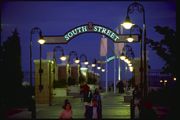 |
South
Street
South
Street was the city limit in William Penn’s plan for a "greene
Country Towne." Today, it is urban to the max — bustling with a
wide variety of restaurants, stores, galleries and performance venues.
If you’re looking for "the hippest street in town," head
south, between Front and 9th. You’re sure to find some
youthful action.
|
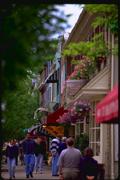 |
Chestnut
Hill
Dining
and shopping along Germantown Avenue have become the thing to do in this
charming neighborhood with the gentility of a bygone era. Northwest of
Center City but still within the city limits, Chestnut Hill began to
flourish in earnest late in the 19th century, with the
extension of the Pennsylvania Railroad line. The main thoroughfare,
Germantown Avenue, is paved in hand-laid Belgian blocks and lined with
restaurants, galleries and boutiques. Beyond "the Avenue,"
visitors find fine examples of Colonial Revival and Queen Anne style
homes. The Woodmere Art Museum, at 9201 Germantown Avenue, is open to
the public.
|
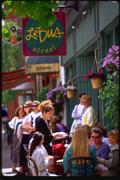 |
Manayunk
What
happens when people discover the charm of a canal-edged Main Street just
minutes from Center City? You get Manayunk — over a half-mile long,
with over 65 shops and galleries and scores of restaurants. Shoppers and
diners enjoy the wealth of possibilities, from Pacific rim relics to
contemporary housewares and designer clothing. Le Bus is just one of the
many Manayunk establishments offering relaxed dining inside and out. |
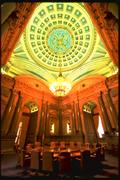 |
City
Council Caucus Room at City Hall
This
skyward view shows the rotunda ceiling in the City Council
Caucus Room of City Hall in Philadelphia. It is just one of many
magnificent features in the nation’s largest and grandest city
hall, designed in the Second Empire style by architect John
McArthur, Jr. and built from 1871 to 1901. |
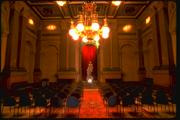 |
Conversation
Hall at City Hall
Conversation
Hall was originally designed as a Council meeting chamber
(hence, the name). However,
it never served this purpose, and
today it operates as an adjunct to the Mayor’s Reception Room.
Located on the second floor in City Hall Tower, this impressive
room features busts of the founding fathers, a statue of George
Washington (featured in the photo), intricate mosaic floors,
granite
columns, and a beautiful brass chandelier. It was
restored circa 1980.
|
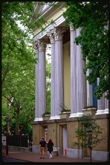 |
Old
Pine Street Church
The
Old Pine Street Presbyterian Church, established in 1768, is the
only remaining
colonial Presbyterian church and churchyard in
America. During the Revolutionary War, occupying British
soldiers burned most of the interior. The space was used as a
hospital and then a stable.
The soaring double Corinthian
columns were added during a restoration in 1830. The church,
located on the corner of 4th and Pine Streets, is
open daily and free to the public. |
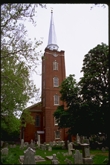 |
St
Peter’s Episcopal Church
St.
Peter’s Episcopal Church has been in continuous use since its
first service in 1761. Mayor
Samuel Powel hosted George and
Martha Washington here in pew 41. In the churchyard lie, among
others, painter Charles Wilson Peale and seven Native American
chiefs. Scottish architect Robert Smith
designed this large,
brick, Palladian-style structure, as well as Carpenter’s Hall
and the steeple on
Christ
Church. William Strickland was
responsible for the tower and spiral, added in 1842. The church
is
located at
3rd and Pine Streets.
|
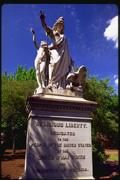 |
Statue
of Religious Liberty
"Religious
Liberty" is a 25-foot marbel monument that was carved in
Italy and shipped to Philadelphia for the nation's Centennial
Exposition in 1876. It was created by Sir Moses Jacob Ezekiel,
the first American Jewish sculptor to gain international
prominence. The statue was dedicated to the people of the United
States to honor their Constitutional guarantee of religious
freedom. In 1985, it was relocated (from Fairmount Park) tot the
grounds of the National Museum of American Jewish History,
located at 55 North 5th Street, (Independence Mall East).
|
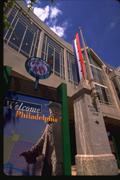 |
Pennsylvania
Convention Center
Opened
in June 1993, the Pennsylvania Convention Center has 1.5 million
square feet of space and an exhibit hall the size of six
football fields. Visitors can cross a sky bridge from the
Philadelphia Marriot
Hotel to view the architectural highlight
of the Center – the magnificently restored, Victorian style
Reading train shed. The Center showcases the largest permanent
collection of contemporary
art, installed throughout the
building. Located at 1101 Arch Street, the Convention Center is
within walking distance of the historic area, shopping and other
tourist attractions. |
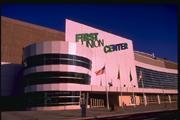 |
Comcast-Spectacor’s
First Union Center
Comcast-Spectacor’s
First Union Center has set the standard for sports and
entertainment facilities, attracting more than 400 annual events
and 4,000,000 visitors. The home of the Philadelphia Flyres
(NHL), the 76ers (NBA) and the Wings (NLL) will also host the
2000 NCAA Women’s Final Four and the Republican National
Convention. With more than 700,000 square feet, Comcast-Spectacor’s
First Union Center can accommodate private parties, social
gatherings and other hospitality requests from 20 to 21,000.
Comcast-Spectacor’s First Union Center is the first arena with
its own microbrewery and cigar club as well as a 24-hour
regional sportsnetwork on the main concourse. The
state-of-the-art facility features five different levels of
seating, including three levels of premium seating (126 luxury
suites
and 14 Club Box sections). Behind-the-scenes tours of
Comcast-Spectacor’s First Union Center are
available.
|
|
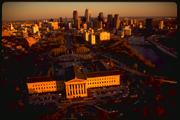 |
Aerial
View of Philadelphia Museum of Art and Skyline
One of
the country’s leading museums, the Philadelphia Museum of Art makes an
impression with its massive structure even before you enter. Modeled
after a temple in the Greco-Roman style, the museum covers l0 acres
where Fairmount Park spills into Center City. The view down the Benjamin
Franklin Parkway from the front steps of the museum is one of the
city’s most breathtaking. The surrounding Philadelphia skyline has an
interesting history. When City Hall (visible at the far end of the
Parkway) was completed in 1901, an architectural "gentlemen’s
agreement" prohibited any building from standing taller than the
hall’s 40 stories or 491 feet. In the 1980s, a developer proposed a
taller structure and a heated debate ensued, one side wanting to
preserve the city’s "human scale" and another wanting to add
drama to the city’s skyline. The latter group won out, and in 1987,
Liberty Place One (61 stories) opened in Philadelphia, followed quickly
by others.
|
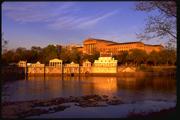 |
ART MUSEUM
From the Schuylkill River, the
Philadelphia Museum of Art rises majestically at the end of the Benjamin
Franklin Parkway. Constructed of Minnesota Dolomite and completed in
1928, the museum covers 10 acres and houses more than 300,000 works
spanning 2,000 years. Beyond individual artworks, the museum offers the
most lavish collection of period rooms found anywhere in America, as
well as suits of armor, an entire Japanese tea house, and other
faithfully reconstructed environments. Below the museum, on Kelly Drive
along the east bank of the Schuylkill, is a section of the city’s
famous Boathouse Row, home to many historic rowing clubs. To the right
in the foreground is the Fairmont Water Works, built in 1812; it
supplied Philadelphia with pure drinking water from the Schuylkill until
1911.
|
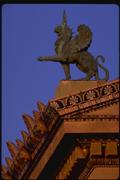 |
Griffin
Adorning the Philadelphia Museum of Art
Several
bronze griffins adorn the roof of the Philadelphia Museum of Art, a
structure that represents the pinnacle of Beaux-Arts craftsmanship in
the United States. These mythological beasts symbolize strength and
vigilance and are said to guard their hoards of fabulous treasure
tirelessly. The world-renowned collection of artwork inside is
symbolically protected by these "Hounds of Zeus." They have
become the symbol for the Philadelphia Museum of Art.
|
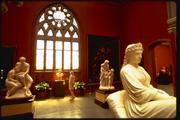 |
Pennsylvania
Academy of the Fine Arts
The
Pennsylvania Academy of the Fine Arts, founded in 1805, is the
nation’s oldest art museum
and school. Housed in a Gothic Victorian
building designed by Frank Furness and George W. Hewitt, it
was
designated a National Historic Landmark in 1975. The museum offers one
of the world’s
finest collections of American painting and sculpture.
Notable alumni of the Academy School
include Mary Cassatt, Thomas Eakins,
Maxfield Parrish and Alexander Calder. It is located at 118
N. Broad
Street (at the corner of Cherry Street), just two blocks from City Hall.
|
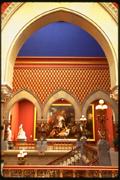 |
Pennsylvania
Academy of the Fine Arts
The
exquisitely restored Pennsylvania Academy of the Fine Arts houses
masterworks by
American artists such as Charles Wilson Peale, Thomas Eakins, Winslow Homer, Horace Pippin
and Andrew Wyeth. Shown here, the
great stairhall leads to the galleries on the second floor.
These
galleries feature natural light and décor that matches their exhibits.
The Academy is located
at 118 N. Broad Street (at the corner of Cherry
Street), just two blocks from City Hall.
|
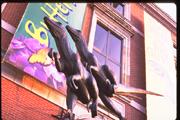 |
Academy
of Natural Sciences
"Discovering
Dinosaurs" in Dinosaur Hall is the most popular attraction at this
distinguished museum and research center on the Benjamin Franklin
Parkway. Here you’ll find the reconstructed skeleton of a
tyrannosaurus rex and a dinosaur dig where kids can hunt for buried
fossils. In another exhibit, live butterflies flutter around you in a
tropical rain forest. Founded in 1812, the Academy is the first museum
of natural history in the country, and the building dates from 1868.
|
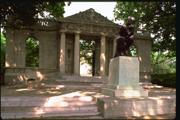 |
Rodin
Museum
Rodin’s
"Thinker" muses at the gateway to the Rodin Museum on the
Benjamin Franklin Parkway. One of the city’s museum gems, this elegant
structure houses the largest collection of work by Auguste Rodin to be
found outside of France. The collection was amassed by Philadelphia
motion picture exhibitor Jules Mastbaum, who assembled his extraordinary
holdings in the space of four years. Beaux Arts architects Paul Cret and
Jacques Gréber designed the building and grounds, with an entry based
on Rodin’s own Chateau D’Issy. The unfinished "Gates of
Hell," with over 200 distinct figures, is the massive centerpiece
of the collection. Only two bronze casts of the work have ever been made
— the one here and one in Paris.
|
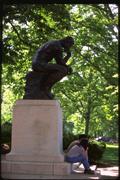 |
The
Thinker
This full
size cast of "The Thinker" greets visitors to the Rodin Museum
in Philadelphia, which also has the largest collection of work by
Auguste Rodin to be found outside of Paris. This pensive figure was
originally conceived by the artist as Danté, contemplating his Inferno.
He sat atop the monumental work "The Gates of Hell," which is
actually comprised of 200 individual figures. The museum is located on
the Benjamin Franklin Parkway between 21st and 22nd
Streets, an easy walk from the grand Philadelphia Museum of Art. |
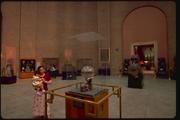 |
Chinese
Rotunda at the University of Pennsylvania Museum of Archaeology and
Anthropology
The
Chinese Rotunda, featuring one of the finest collections of Chinese
monumental sculpture in
the United States, is one of the 30 galleries in
this museum on the campus of the University
of Pennsylvania. A visitor
and her child are admiring a crystal ball once owned by the Empress
Dowager
of China. The world-renowned museum, designed by Italian born
architect Wilson Eyre, Jr.,
among others, opened in 1899 and houses
nearly one million artifacts from around the world. It
is located at 33rd
and Spruce Streets, within easy reach of Center City by public
transportation or
on foot.
|
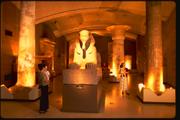 |
Lower
Egyptian Gallery at the University of Pennsylvania Museum of Archaeology
and Anthropology
The
Lower Egyptian gallery of the world-renowned University of Pennsylvania
Museum of Archaeology and Anthropology includes the 12-ton granite
Sphinx of Ramesses II among its treasures. The
museum, designed by
Italian born architect Wilson Eyre, Jr. and others opened in 1899 and
houses nearly one million artifacts from around the world. It is located
at 33rd and Spruce
Streets, within easy reach of Center City
by public transportation or on foot.
|
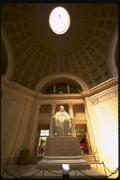 |
Benjamin
Franklin Memorial at the Franklin Institute Science Museum
The
heroic, 30-foot statue of Benjamin Franklin presides over the octagonal
Benjamin Franklin Memorial Chamber which was inspired by the Pantheon in
Rome. The Franklin Institute, named to honor inventor and scientist
Benjamin Franklin, is the oldest organization in the United States
devoted to the study and promotion of mechanical arts and applied
sciences. The Institute was founded in 1824 by Samuel Vaughan Merrick.
The current building, at 20th and the Benjamin Franklin
Parkway, also houses an interactive museum of science and technology and
a giant screen, educational movie theater. The original building was
completed in 1934 and modeled after the Deutsches Museum of Munich.
|
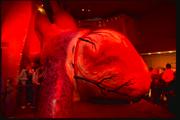 |
Walk-Through
Model of a Human Heart at the Franklin Institute Science Museum
One of
the most popular activities at the Franklin Institute is walking through
the world’s largest artificial heart (220 times life-size). Other
exhibits at this beloved family attraction include the cockpit of a T-33
jet trainer, a 350-ton Baldwin steam locomotive that actually runs,
astronomy shows in the Fels Planetarium, and giant screen films in the
Tutltleman Omniverse Theater.
|
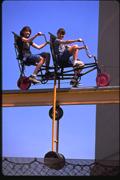 |
Sky
Bike at First Union Science Park Outside the Franklin Institute Science
Museum
Children
ride the Sky Bike at First Union Science Park, a play-and-learn area
attached to the Franklin Institute Science Museum and Please Touch
Museum®. Eighteen feet above the rest of the science park, this
demonstration of gyroscopic stability is a favorite among young
visitors. The Franklin Institute is located at 20th and the
Benjamin Franklin Parkway. |
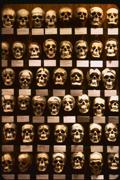 |
Mutter
Museum
This
collection of 139 skulls is found in one of the most unusual museums
anywhere — the Mütter Museum of the College of Physicians of
Philadelphia, which offers specimens of anatomy and pathology and
historic medical instruments. Imagine the skeleton of a 7’6"
giant and a 3’6" dwarf, bone and tissue fragments from famous and
infamous Americans, a plaster cast of the original Siamese Twins, as
well as old medical kits, lobotomy instruments, an early 20th
century doctor’s office, and an iron lung. Adjacent to the Museum is
the College Gallery for changing exhibits on current medical topics,
such as Emerging Infectious Diseases. The Museum and Gallery are located
in the 1908 Gregorian-style building of the College of Physicians. The
College was established by Benjamin Rush and twenty-three other
prominent physicians in 1787, and is the oldest surviving private
medical society in the country. The College is dedicated to enhancing
the public’s understanding of current and historical medicine and of
the role of the physician in society. It is located on 22nd
Street between Market and Chestnut.
|
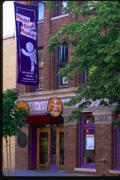 |
Please
Touch Museum®
Please
Touch Museum® opened in its current location at 210 North 21st Street
in 1983, with
the innovative mission of providing an educational, fun,
and safe experience for children ages 1 to 7. One of its interactive
exhibits, "Alice’s Adventures In Wonderland," allows
children to live the
wild adventures in this classic tale. Other
exhibits include "Sendak," a journey through four of
Maurice Sendak’s most popular books; "Studio PTM," a child-size
television studio; and "Move It,"
an exhibit teaching children
about different forms of transportation. In late 2001, Please Touch®
plans to expand and relocate within the Penn's Landing Family
Entertainment Center.
|
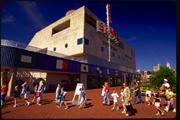 |
Independence
Seaport Museum at Penn’s Landing
Independence
Seaport Museum captures the Philadelphia region’s maritime heritage
with family-oriented interactive exhibits, ship models, artifacts and
art. Visitors can explore the Museum, watch a wooden boat being built,
climb aboard Admiral Dewey’s 1892 cruiser OLYMPIA, tour the WWII
submarine BECUNA and visit the museum’s nautical gift shop. This
10,000 square foot maritime museum is located at the Delaware River’s
edge on Penn’s Landing, just a short walk from Independence Hall and
the Liberty Bell.
|
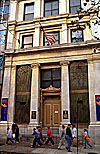 |
National
Liberty Museum
The National Liberty Museum in Old City,
Philadelphia, celebrates America’s heritage of freedom through
computer interactives, videos, exhibits and artwork. |
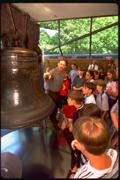 |
LIBERTY
BELL
Tradition tells of a chime that
changed the world on July 8, 1776, with the Liberty Bell ringing out
from the tower of Independence Hall summoning the citizens of
Philadelphia to hear the first public reading of the Declaration of
Independence by Colonel John Nixon.
LOCATION: 6th and Market Streets, in the Historic
District of Philadelphia, Pennsylvania. Open daily 9am-5pm with extended
hours July and August. The bell is visible 24 hours a day. 215-597-8974 [MAP
OF HISTORIC PHILADELPHIA |
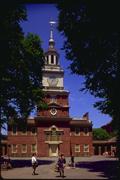 |
Independence
Hall
Located
on Chestnut Street between 5th and 6th Streets.
The building is open year round,
though hours vary by season. Visitors
are admitted free of charge by tour only. Constructed
between 1732 and
1756 as the state House of the Province of Pennsylvania, it is
considered a
fine example of Georgian architecture. In the Assembly Room
of this building, the Declaration
of Independence was adopted on July 4,
1776.
|
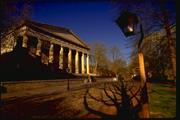 |
Second
Bank of the United States
Designed
by William Strickland, this building, built between 1819 and 1824, is
one of the finest examples of Greek Revival architecture in the United
States. Today the building houses an extensive collection of late 18th
and early 19th century portraits.
Located
on Chestnut Street, between 4th and 5th Streets
the building houses the "Portraits of the Capital City"
includes 185 paintings of Colonial and Federal leaders, military
officers, explorers and scientists, including many by Charles Willson
Peale. You can explore the gallery on your own, or guided tours are
given upon request. The Second Bank is open daily.
|
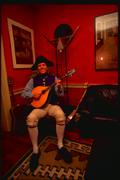 |
Elfreth’s
Alley: Fete Day
Colonial
times were tough, and here a colonial re-enactor teaches today’s
children how to defend their country during Fete Days in Elfreth’s
Alley. This tiny, cobblestone street is the oldest continuously occupied
residential block in America, dating to 1702. The Elfreth’s Alley
Museum, at Number 126, is fully restored as a Colonial dressmaker’s
home with authentic furnishings and kitchen and is open year-round.
During Fete Days, the first weekend in June, Elfreth’s Alley residents
dress in period costume and open their homes to the public. Homes are
also open on the first weekend in December. The alley is tucked away
between Front and 2nd Streets, between Arch and Race.
|
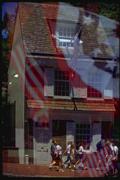 |
Betsy
Ross House
The Betsy
Ross House, built in 1760, is seen here reflected in the window of a
flag shop across the 200 block of Arch Street. A beautiful Colonial
Philadelphia residence, the house normally flies the 13-star flag in its
second-floor window to commemorate the first Stars and Stripes. This
flag is widely believed to have been made by Ross to celebrate
Independence in July of 1776. The eight-room house is full of artifacts
such as a family Bible and the mistress’s chest of drawers and reading
glasses. The small rooms are furnished with period pieces to reflect the
life of the hardworking Quaker seamstress whose husband John owned an
upholstery business and who was known for stitching ships’ colors
during the Revolution.
CHECK OUT THE EDGAR ALLAN POE HOUSE RIGHT NEAR HERE
|
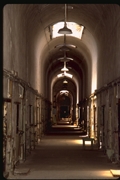 |
Bastille
Day at Eastern State Penitentiary
Celebrate
Bastille Day at Eastern State Penitentiary. Help storm the Bastille and
join the crowds in deciding the fate of Marie Antoinette. Philadelphia,
the home of American independence, is also the site of this rousing
re-enactment of the French Revolution. It occurs at an 11-acre, historic
prison in the Fairmount section of the city. |
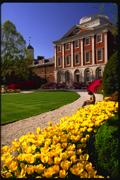 |
Pennsylvania
Hospital
A
sweeping garden graces the front of Pennsylvania Hospital, the oldest
hospital in the United States, founded in 1751. It houses the nation’s
first medical library and first surgical amphitheater from 1804, as well
as a portrait gallery, early medical instruments, art objects, and a
rare-book library with items dating from 1762. Today, Pennsylvania
Hospital functions as a full-service modern medical center. It is
located at 8th and Spruce Streets. |
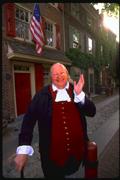 |
Benjamin
Franklin
Benjamin
Franklin (played here by an actor, standing on Elfreth’s Alley) is
considered one of the greatest public figures in the history of our
nation. He arrived in Philadelphia as a runaway apprentice from Boston
in 1723. Until his death in 1790, he served the fledgling country as a
printer, scientist, journalist, linguist, lawmaker, inventor,
businessman and philosopher. Franklin was concerned with every trend
that affected Philadelphia and the nation. He was instrumental in
establishing such basic institutions as the postal service, fire
companies, early hospitals and libraries. He even conceived of the first
lottery (as a fund-raising measure during the French and Indian War) and
the first matching grant (for the building of Pennsylvania Hospital).
Franklin is also renowned as a pioneer in the field of electricity and
his kite-and-key experiment is emblematic of scientific research.
|
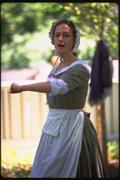 |
Colonial
Re-enactor in the Historic District
Philadelphia
is a place where history reaches out and touches our lives. As the
"nation’s birthplace," the city offers visitors the
opportunity to trace the steps of our founding fathers (and mothers!)
and experience great moments such as the signing of the Declaration of
Independence or the drafting of the United States Constitution. Talented
colonial re-enactors recreate the music, language and lifestyle of those
momentous times and bring history off the page into vivid
three-dimension.
|
SHOPPING
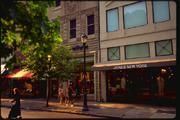 |
Rittenhouse
Row
Shoppers
love Philadelphia! Strolling on Walnut Street, you’re in the heart of
Rittenhouse Row, surrounded by over 200 upscale dining, retail and
cultural establishments. This is one of the nation’s most exclusive
shopping neighborhoods, stretching from the Avenue of the Arts (Broad
Street) to 21st Street, between Spruce and Market Streets.
Rittenhouse Row is brimming with art galleries, haute couture boutiques,
national retailers, specialty shops, luxurious spas and salons,
restaurants and cafés. Whether you’re looking for a bargain, a bauble
or a bagette, you’ll find it here.
|
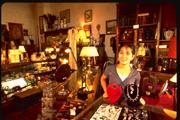 |
Antique
Row on Pine Street
Just six
blocks from the Pennsylvania Convention Center, antique-lovers can hunt
for treasures in the shops along Pine Street (from 10th to 18th).
From colonial heirlooms to 1950s kitsch, there’s something for
everyone along this eight-block stretch known as "Antique
Row." Restaurants and coffee shops provide a chance to rest your
feet and admire your purchases.
|
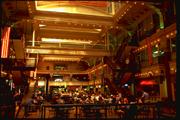 |
The
Bourse Shopping Mall
The
Bourse, a unique urban shopping mall, is located just east of the
Liberty Bell on 5th Street, between Market and Chestnut. This
delightful, late-Victorian building first opened in 1895 as home to
Philadelphia’s maritime, stock and grain exchange, and was renovated
in 1982 as an office and retail complex. With its airy atrium food court
and many gift and souvenir shops, The Bourse is a convenient and
refreshing stop for visitors to the historic district.
|
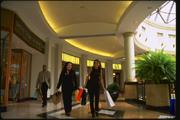 |
King
of Prussia Mall
Three
miles south of Valley Forge National Historical Park, King of Prussia
The Plaza & The Court comprise the Nation’s largest retail
shopping complex. Visitors can purchase clothing tax-free at 8
department stores (more than any other mall in the world) and over 350
specialty shops. Satisfy shopping-induced hunger at one of the mall’s
40 eateries.
|
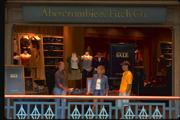 |
King
of Prussia Mall
YOU'LL
NEED A MAP TO FIND YOU WAY OUT OF HERE!
King
of Prussia The Plaza & The Court, the Nation’s largest
retail-shopping complex, visitors will find shopping options for all
budgets. They can choose from eight department stores (more than any
other mall in the world) and hundreds of specialty shops such as Louis
Vuitton, Gianni Versace, Abercrombie and Fitch, The Limited and The Gap,
more than any other mall in the world! Shoppers never pay sales tax on
clothing in Pennsylvania.
|
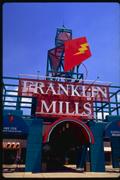 |
Franklin
Mills Mall
Franklin
Mills, the Landmark of the Discount Shopper, offers bargain hunters top
designer names at up to 60% off designer merchandise every day — with
no sales tax on clothing in Pennsylvania. This 1.7 million-square-foot
enclosed mall is located only 15 miles from Center City Philadelphia and
is home to 200 great stores, two food courts, seven theme restaurants
and a 14-screen movie theater. Daily shuttle services from Philadelphia
hotels, airport and train station is available. Shuttle service is also
available on Academy Bus Lines departing from the Port Authority weekly
in New York City. |
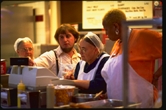 |
Reading
Terminal Market
The
Reading Terminal Market, at 12th and Arch Streets, was
established in 1893 and is the nation’s oldest continuously operating
farmers’ market. Visitors enjoy eating virtually every type of
cuisine, from soul food to Asian and Middle Eastern dishes to
traditional Pennsylvania Dutch fare — all available from largely
family-run stands. Cooks come to the market for the very freshest in
meats, poultry, fish and specialty ingredients. Cooking demonstrations
and cookbook signings are frequent events. The northwestern corner of
the market is primarily devoted to Lancaster County Amish merchants who
bring their farm-fresh products and distinctive prepared dishes.
Sit-down eateries are scattered throughout the market. Cookware, plants
and flowers, books and many other items are also available.
|
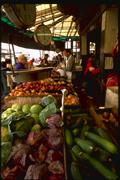 |
The
Italian Market
Here’s
a piece of Italy hiding in Philadelphia. It’s the Italian Market, an
outdoor and storefront culinary delight . Discover meats, cheeses,
spices and produce the way they were meant to be enjoyed: fresh, local,
lovingly purveyed. Small, family-run restaurants, and cafés surround
the main corridor, which stretches along 9th Street between
Christian Streets to Wharton Streets. It’s just across the southern
border of center city. So put on your walking shoes and prepare for an
adventure! |
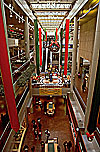 |
The
Gallery at Market East
One of the nation’s largest urban shopping
center, spanning nearly four blocks, is home to nearly 170 stores and 40
eateries. In addition, some 50 pushcart merchants offer a variety of
unique items. |
 |
Shopping
on Rittenhouse Row
Upscale shops, salons and boutiques line Walnut
Street between Broad to 20th Streets. Francis Jerome, Sophy
Curson, Nicole Miller and Ralph Lauren are among the streets big-name
retailers.
|
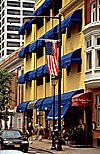 |
Shopping
on Rittenhouse Row
Upscale shops, salons and boutiques line Walnut
Street between Broad to 20th Streets. Francis Jerome, Sophy
Curson, Nicole Miller and Ralph Lauren are among the streets big-name
retailers. |
 |
Shopping
in New Hope
Unique shops, restaurants, galleries and
studios line the streets of historic New Hope, PA, a charming Bucks
County town just 35 miles north of Philadelphia.Check out Shippack Village too~Located on Rt.
73 & Skippack Pike |
My
RESTAURANTS
& BAR PICKS
 |
Blue Bell Inn-Restaurant
Since
1743, the Blue Bell Inn has been serving guests food and beverage, and
its earliest days offered lodging. The historic building was known as
the White House until 1796 and was marked on George Washington's
military maps of 1777 which led Washington and his troops to the Battle
of Germantown. The old well at the Inn provided water for the troops
during the journey, much to the fear of the Hessian mercenaries that
were hiding in a cubbyhole in the basement.
Today, the
award winning Blue Bell Inn is famous throughout the Delaware Valley for
its fine food. John Lamprecht, its owner-proprietor and executive chef,
has followed a family tradition started by his father who was once the
garde-manger at the Warwick Hotel and is known to be the creator of
Lamaze Sauce. The building was extensively remodeled and while the
exterior still remains an imposing 18th century white building, the
interiors are contemporary and spacious.
Blue
Bell Inn
601 Skippack Pike
Blue Bell, Pa 19422
(215) 646-2010 Reservations
(215) 646-2426 Fax
|
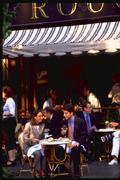 |
Rouge
99
An
intimate, French bistro atmosphere presides at this popular
restaurant/bar/outdoor café located right on Rittenhouse Square. Guests
can sip cocktails and eat imaginative cuisine while people-watching on
the Square, thanks to heat lamps that keep the sidewalk cosy year-round.
Rouge 99 is located at 205 South 18th Street, around the
corner from the Rittenhouse Row shopping district.
|
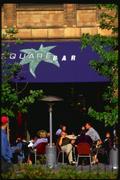 |
Square
Bar
Square
Bar is an intimate Italian restaurant located in the Sheraton
Rittenhouse Square Hotel at 18th and Locust Streets. Outdoor
seating, facing the city’s most beautiful square, adds to the appeal
of this café style eatery. It’s an ideal spot to take a break from
shopping and to enjoy the vibrant life on the Square.
|
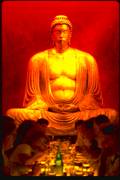 |
Buddakan
A
towering gilded statue of the Buddha generates elegant calm in this
175-seat, Pan Asian restaurant with sleek, modern decor. This immensely
popular addition to Old City features two full bars as well as a
20-person community table for sharing food and conversation. Buddakan is
located at 325 Chestnut Street, east of Independence National Historical
Park. |
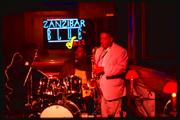 |
Zanzibar
Blue
The
Pat Tandy Quartet is one of many hot acts that perform at Zanzibar Blue,
a restaurant, bar and jazz club. Patrons enjoy the sweet sounds of jazz
seven nights a week in an upscale environment with sophisticated
cuisine. Local talent fills the bill on week nights, with national
headliners on weekends. Zanzibar Blue is located at 200 South Broad
Street on the Avenue of the Arts.
|
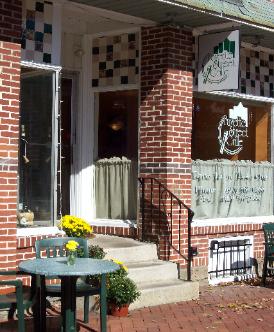 |
Fayette Street Grill (LOVE
IT!!!!!!!)
Fayette Street Grille-308 Fayette
Street-Conshohocken, PA 19428- 610-567-0366 or fax:610-567-0368*
Email t:
Fayette
Street Grille
(Please
call for all reservations /except Chef's Table reservations)
http://www.fayettestreetgrille.com/index.html
|

 |
Spamps (LOVE IT!!!!)
An
eclectic eatery that dishes up everything from steak and salads to
seafood & Sushi
Spamps restaurant is proudly owned by Mike
Spampinato. His thirty plus years of restaurant experience are evident
in his old-world charm, tasty recipes, and family appeal. He is nicely
complimented by his youngest daughter, Marcie, who is managing the
restaurant.
Her teachings from the
hotel/restaurant management program at Penn State University offer a
contemporary edge to the warm atmosphere. Thanks to the decorating
expertise of wendy, mike's wife, Spamps is looking fantastic. You can
catch Carie & Jonie, Mike's other daughters, working at spamps
regularly. So, please come to spamps, to meet the spamps, and enjoy!
Bar: A rectangular copper bar features a contemporary decor with
welcoming atmosphere. Top-shelf spirits promise a perfect martini or
cocktail. An assortment of imports, domestics, microbrews, and premium
draught beers quenches everyone's needs.
Sushi Bar: Featuring the talents of sushi chefs Has and Ito
http://www.spampsrestaurant.com/ |
|

|
Reading
Terminal Market
The
Reading Terminal Market, at 12th and Arch Streets, was
established in 1893 and is the nation’s oldest continuously operating
farmers’ market. Visitors enjoy eating virtually every type of
cuisine, from soul food to Asian and Middle Eastern dishes to
traditional Pennsylvania Dutch fare — all available from largely
family-run stands. Cooks come to the market for the very freshest in
meats, poultry, fish and specialty ingredients. Cooking demonstrations
and cookbook signings are frequent events. The northwestern corner of
the market is primarily devoted to Lancaster County Amish merchants who
bring their farm-fresh products and distinctive prepared dishes.
Sit-down eateries are scattered throughout the market. Cookware, plants
and flowers, books and many other items are also available.
|
 |
The
Italian Market
There’s
a piece of Italy hiding in Philadelphia. It’s the Italian Market, an
outdoor and storefront culinary delight . Discover meats, cheeses,
spices and produce the way they were meant to be enjoyed: fresh, local,
lovingly purveyed. Small, family-run restaurants, and cafés surround
the main corridor, which stretches along 9th Street between
Christian Streets to Wharton Streets. It’s just across the southern
border of center city. So put on your walking shoes and prepare for an
adventure! |
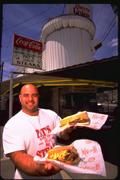 |
Pat’s
Steaks
The
cheesesteak sandwich is a Philadelphia tradition and Pat’s is where it
all began. Thin slices of beef are smothered in melted cheese (onions
and sauce optional), encased in a crusty, Italian roll. Locals have been
known to ship them to friends and relatives across the country who miss
that Philly taste. From presidents to movie stars, visitors flock to try
this quintessential Philadelphia eating experience. Pat’s is located
at 1237 East Passyunk Avenue, a short cab ride from Center City. |
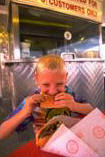 |
Gina's Steaks
Prepared
just the way you like it! No matter when you get a hankering for a
Philadelphia original, Gina's is open around the clock. This South
Philadelphia landmark is directly across the street from Pats...ech! lol
|
 |
Old
City Coffee
Old City Coffee, located at 221 Church Street,
is the perfect spot to grab a cup of coffee and a bit to eat. |
 |
Warmdaddy’s
Live blues music makes Warmdaddy’s a
happening scene six nights a week. The Old City hot spot also serves a
combination of traditional and modern Southern cuisine. |
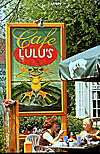 |
Café
Lulu’s
Café Lulu’s is one of more than 30 eateries
located in historic New Hope, PA. The charming Bucks County town, just
35 miles north of Philadelphia, is home to many unique restaurants,
shops, galleries and studios.
|
Cultural Sites &
Attractions/Public Art
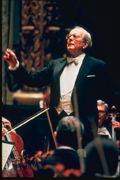 |
Philadelphia
Orchestra
For
many people, a visit to Philadelphia isn’t complete without hearing
a concert by the world famous Philadelphia Orchestra, here conducted
by Music Director Wolfgang Sawallisch. The orchestra celebrates its
Centennial in the year 2000, and it has a history of great music
directors including Leopold Stokowski, Eugene Ormandy and Riccardo
Muti. In an average season, the Orchestra performs nearly 200
concerts, many with the finest guest soloists in the world.
|
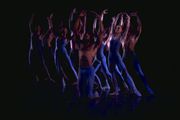 |
Pennsylvania
Ballet
The
Pennsylvania Ballet, one of the nation’s foremost dance companies,
was founded in 1963 and has a performance season from October to June.
This energetic and versatile ensemble is known for its command of the
Balanchine repertoire, in addition to work by other contemporary
ballet masters, full-length classics and premieres of innovative new
work. Here, the company is shown performing The River by Alvin
Ailey. Highlights of the 1999-2000 season include: Kevin O’Day’s
critically acclaimed Col Legno, Agnes de Mille’s masterwork Rodeo,
a new work set to the country rhythm and blues songs of Lyle Lovett,
John Cranko’s Romeo and Juliet, and the premiere of Ben
Stevenson’s spectacular Dracula.
|
 |
Reading
Terminal Market
The
Reading Terminal Market, at 12th and Arch Streets, was
established in 1893 and is the nation’s oldest continuously
operating farmers’ market. Visitors enjoy eating virtually every
type of cuisine, from soul food to Asian and Middle Eastern dishes to
traditional Pennsylvania Dutch fare — all available from largely
family-run stands. Cooks come to the market for the very freshest in
meats, poultry, fish and specialty ingredients. Cooking demonstrations
and cookbook signings are frequent events. The northwestern corner of
the market is primarily devoted to Lancaster County Amish merchants
who bring their farm-fresh products and distinctive prepared dishes.
Sit-down eateries are scattered throughout the market. Cookware,
plants and flowers, books and many other items are also available.
|
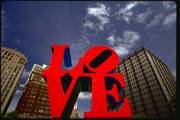 |
LOVE
Statue
Arguably
the most popular sculpture in Philadelphia, LOVE, by artist Robert
Indiana, debuted in John F. Kennedy Plaza during the 1976 Bicentennial
celebration. Philadelphians were incensed when it was removed and
returned to the artist. In response, F. Eugene Dixon, former owner of
the Philadelphia 76ers basketball team, bought the sculpture and
donated it to the city in 1978. Today, it sits in the Plaza at 15th
and Kennedy Boulevard and is the symbol for the city’s tourism
marketing effort, inspiring the tagline: "Philadelphia the place
that LOVES YOU BACK."
|
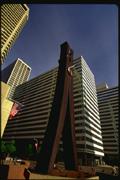 |
Clothespin
Claes
Oldenburg’s 45-foot-high, 10-ton sculpture stands in front of the
Center Square Building at 15th and Market Streets, near
City Hall. Criticized by many at its debut in the Bicentennial year,
this whimsical giant of pop art now co-exists peaceably with the
city’s mostly traditional outdoor statuary. The metal fastening at
the top reads "7" on one side and "6" on the
other, in the Bicentennial spirit. Philadelphia is known for its
extensive collection of public art, including more murals than any
other American city. |
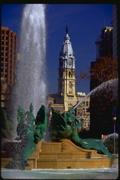 |
Swann
Fountain
On hot
summer days, Swann Memorial Fountain, also known as "The Fountain
of Three Rivers," is a favorite oasis for city residents and
visitors alike. Its majestic plumes of water frame City Hall tower in
the distance. This sumptuous fountain on the Benjamin Franklin Parkway
honors Wilson Cary Swann, a Philadelphia physician who championed
drinking fountains for people and troughs for horses throughout the
city in the 19th century. Wilson Eyre conceived the
fountain’s overall form, while Alexander Stirling Calder crafted the
dramatic sculptures from 1921-24. The three main figures of Swann
Fountain represent the city’s major waterways: the Delaware,
Schuylkill and Wissahickon Rivers.
|
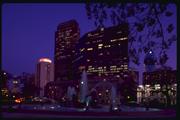 |
Swann
Memorial Fountain at Logan Circle
Swann
Memorial Fountain on the Benjamin Franklin Parkway is one of the most
outstanding examples of public art in Philadelphia. Lit at night, its
graceful sprays of water create a magical oasis on the Benjamin
Franklin Parkway. The fountain was magnificently restored in 1990. The
bronze sculptures, created by Alexander Stirling Calder in the early
1920s, represent the city’s three main waterways—the Schuylkill,
the Delaware, Wissahickon creek. Smaller, water-spouting frogs and
turtles delight children. For residents and visitors, Swann Fountain
is a place to refresh, contemplate, and celebrate.
|
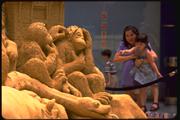 |
Sand
Sculpture at Liberty Place
The
Vitetta Group Sand Sculpture at Liberty Place (a shopping mall in the
heart of downtown Philadelphia) was one of the artworks created as
part of the 1999 Sunoco Welcome America! Festival, which culminated on
July 4th. These are not your average sandcastles. Looming
high above visitors’ heads and crafted with breathtaking detail,
these sculptures celebrate Philadelphia’s historical past and
exciting present. In this detail, one can see chimpanzees from the new
Primate House at the Philadelphia Zoo.
Photo
credit: Photo by George Widman © 1999 by Greater Philadelphia Tourism
Marketing Corporation.
|
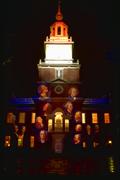 |
PECO
Energy Lights of Liberty
"Revolution.
As it happened, where it happened." A combination of 3-D audio
headsets, historical surroundings, and incredible visual and special
effects bring history to life in this walking show of the historic
district in Philadelphia. The PECO Energy Lights of Liberty show is a
breathtaking, entertaining and educational experience.
|
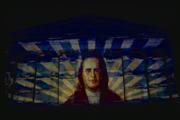 |
PECO
Energy Lights of Liberty
Watch
the events that shaped our nation’s birth and feel a part of the
action. The PECO Energy Lights of Liberty show combines cutting edge
technology with historic settings to bring history to life.
Photo
credit: Photo by Bob Krist © 1999 by Greater Philadelphia Tourism
Marketing Corporation.
|
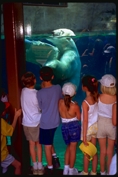 |
Philadelphia
Zoo
In
"Bear Country" at the Philadelphia Zoo, visitors watch polar
bears swim in a 200,000-gallon tank with glass walls. Established in
1859, this is the oldest zoo in America, and it is home to more than
2,000 animals representing six continents. The zoo houses rare white
lions, giant otters, exotic rainforest animals, a hummingbird exhibit,
the newly renovated Amphibian and Reptile House and the innovative new
PECO Primate Reserve. The zoo is located at 34th Street and
Girard Avenue, in Fairmount Park, just minutes from the downtown area
off I76.
|
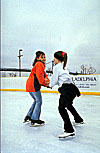 |
Blue
Cross RiverRink
Kids can’t get enough of the Blue Cross
RiverRink, Penn’s Landing’s open-air ice skating rink, located at
Columbus Boulevard and Spring Garden Street. Special events every
weekend make the rink a must-visit for families.
Photo Credit: Photo by L. Wuillermin © 2000
by Greater Philadelphia Tourism Marketing Corporation.
|
 |
Blue
Cross RiverRink
Kids can’t get enough of the Blue Cross
RiverRink, Penn’s Landing’s open-air ice skating rink, located at
Columbus Boulevard and Spring Garden Street. Special events every
weekend make the rink a must-visit for families.
Photo Credit: Photo by L. Wuillermin © 2000
by Greater Philadelphia Tourism Marketing Corporation.
|
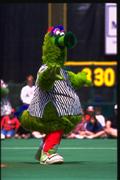 |
Phillie
Phanatic
Phillies
baseball games have been a Philadelphia tradition since the team’s
debut on May 1, 1883. The Phillies mascot, the "Phillie Phanatic,"
has frolicked and cheered with fans since 1978. Famous for antics like
shooting hotdogs into the crowds, the ever ebullient Phanatic makes
every game a winner.
|
MONTGOMERY COUNTY
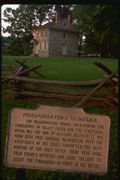 |
VALLEY
FORGE PARK
After
Revolutionary forces suffered losses at Brandywine and Germantown,
General Washington led his troops to Valley Forge. Today, the Valley
Forge National Historical Park offers visitors the opportunity to
explore replicas of the soldiers’ huts and some of the officers’
lodgings. Although many lives were lost during the cold winter months
that Washington camped here with his men, by springtime, the troops
regained their strength and fought victoriously for independence.
|
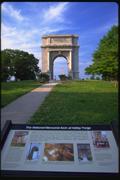 |
National
Memorial Arch at Valley Forge National Historical Park
The
National Memorial Arch at Valley Forge was constructed in 1914 to
honor George Washington and his troops, who endured bitter winter
months here. The arch stood for over 80 years, but by the mid-1900s it
was in need of structural repairs. Restoration was undertaken in
1996-97 by the Freemasons of Philadelphia, to acknowledge the heroism
and leadership of George Washington, a prominent freemason, as well as
his soldiers.
|
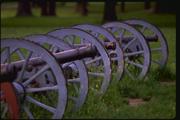 |
Cannons
in the Valley Forge National Historical Park
Replicas
of Revolutionary cannons rest in Artillery Park. This section of the
3,000-acre Valley Forge National Historical Park was a storage place
for colonial arms. The park marks the area used as a base by George
Washington and his troops during the momentous winter of 1777-78, when
Washington’s Continental Army of 12,000 used virtually all of the
park’s acres for their livestock and log cabins.
|
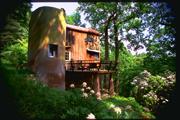 |
Wharton
Esherick Museum (exterior)
Woodworker
Wharton Esherick helped to create the American sculpture style early
in the 20th century. His wonderfully quirky home studio and
workshop were built over four decades.The workshop which is currently
a private residence, was designed by the renowned architect Louis
Kahn. All reflects Esherick’s unique thinking about form and
material. Esherick’s style is present in every detail, from the
camouflage tower to the door hinges, light switches and winding
stairs. Over 200 works in wood are displayed, many of them marvels of
ingenuity and craftsmanship.
Photo
credit: Photo by George Widman © 1999 by Greater Philadelphia Tourism
Marketing Corporation.
|
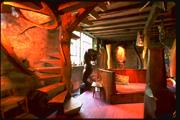 |
Wharton
Esherick Museum (interior)
The
home and studio of painter-turned-woodworker Wharton Esherick, are now
open to the public as a museum. Tours offer visitors a rare
opportunity to see an artist’s work in the environment in which it
was created. Over 200 of Esherick’s works are displayed. The
interior and exterior of the complex embody Esherick’s unique vision
and ability to combine beauty, form and function in furnishings as
well as in art.
Photo
credit: Photo by George Widman © 1999 by Greater Philadelphia Tourism
Marketing Corporation.
|
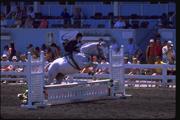 |
Devon
Horse Show
The
Devon Horse Show is the oldest and largest outdoor multi-breed horse
competition in the United States, dating back to 1896. Ever popular
among competitors and spectators from around the world, the show
maintains its country fair atmosphere, rich with local traditions of
the Philadelphia Main Line.
|
 |
THE
PHILADELPHIA RACE TRACK AND CASINO
http://www.philadelphiapark.com/ |
BUCKS COUNTY
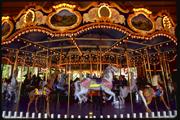 |
Grand
Carousel at Peddler’s Village
Take a
spin on the splendidly restored, 1922 Grand Carousel at Peddler’s
Village. This charming, colonial style town offers 75 specialty shops
plus a variety of restaurants and 166 room inn. Special events occur
throughout the year, including: Evening in a Colonial Kitchen;
Scarecrow Competition Display; and Teddy Bear’s Picnic. Peddler’s
Village is located between New Hope and Doylestown, in Lahaska, PA.
|
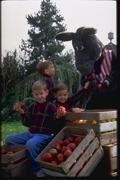 |
Apple
Festival at Peddler’s Village
Peddler’s
Village has small town, colonial charm, with over 75 specialty shops,
restaurants and 166 room inn spread across acres of landscaped grounds
and winding walkways. The Apple Festival, one of many themed weekends,
is held every year in November. People of all ages enjoy shopping,
crafts, live entertainment and, of course, lots of apples.
Photo credit: Photo courtesy of
Peddler’s Village.
|
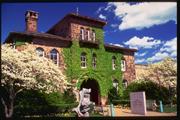 |
James
A. Michener Art Museum
The
building that originally served as the Bucks County jail now houses an
art museum honoring Pulitzer Prize winning writer, James A. Michener.
The collection — a gift from Michener to his native Bucks County —
includes primarily works of 19th and 20th
century American art, many by Bucks County painters and sculptors. The
museum’s reading room is named for the late George Nakashima, a
celebrated woodworker who also practiced his art in this area. The
museum is located at 138 South Pine Street in Doylestown, PA.
Photo
credit: Photo courtesy of Stephen Barth for the Bucks County
Conference & Visitors Bureau, Inc.
|
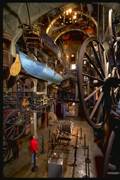 |
Mercer
Museum
The
Mercer Museum opened in 1916, one of three buildings that form the
legacy of Henry Chapman Mercer. This eccentric historian, architect,
anthropologist and archaeologist became devoted to tile making, and
Mercer tiles are widely known and valued. The museum houses Mercer’s
collection of tools, representing over 60 crafts, and more than 50,000
objects created before the age of steam. The four-story central court
of the museum is crammed with log sleds, cheese presses, fire engines,
boats, and bean hullers, suspended by wires from the walls and
ceiling. The Mercer Museum is located at 84 South Pine Street in
Doylestown, PA.
|
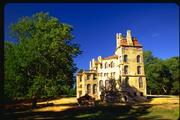 |
Fonthill
Henry
Chapman Mercer, a Harvard educated millionaire, designed and
constructed this unique mansion in 1910 entirely of reinforced
concrete. Modeled after a 13th century Rhenish castle,
Fonthill was built from the inside out, without using blueprints.
Inside, Fonthill surprises visitors with Gothic doorways, sudden
stairways, dead ends and inglenooks. The ceilings and walls are
embedded with tiles from Mercer’s own kilns and with ancient tiles
from around the world. Fonthill is located at East Court Street and
Swamp Road in Doylestown, PA.
|
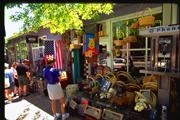 |
New
Hope
New
Hope, formerly a colonial-style town, is now an artists’ mecca
filled with specialty shops, restaurants and galleries. The town sits
on the banks of the Delaware River, and its Main Street is lined with
outdoor porch bars and restaurants, some with great river views. New
Hope is just a few miles from Washington Crossing, along River Road in
Bucks County, PA.
|
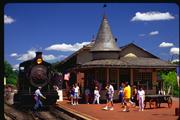 |
"New
Hope & Ivyland Railroad
All
aboard! The Ivyland Railroad in New Hope leaves from the New Hope
depot, a Victorian gem of a building dating to the 1890s. The train,
one of the few remaining steam powered engines, takes passengers on a
nine-mile, 50-minute, scenic journey from downtown New Hope west to
Lahaska. En route, the train crosses a trestle used in many rescue
scenes in the classic "Perils of Pauline" movies. The
station is located at West Bridge and Stockton Streets in New Hope.
|
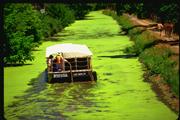 |
Mule-Drawn
Canal Boat Ride on the Delaware Canal
Coal
barges began traveling the Delaware Canal in 1832. Today, the canal is
part of the Delaware canal State Park where the New Hope Mule Drawn
Canal Boat Ride offers rides on a mule-pulled barge, available from
April to November. The one-hour, narrated excursions glide past
Revolutionary-era cottages, gardens, and artists’ workshops. The
entrance is located at New and South Main Streets in downtown New
Hope, PA. |
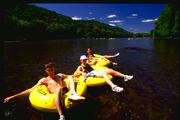 |
Tubing
Down the Delaware River – "Bucks County River Country"
Just
one hour from Philadelphia, the Delaware River is perfect for tubing,
canoeing, rafting and kayaking. There are number of rental companies
that cater to individuals and groups. Point Pleasant, PA, just a few
miles north of New Hope, is the center of this delightful river
activity. The season runs from April to October. This is great but
watch out for floaters!
|
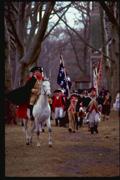 |
Re-enactment
of Washington Crossing the Delaware
George
Washington crossed the Delaware River on December 25, 1776, to launch
his decisive attack on enemy forces in Trenton. Today, historical re-enacters
faithfully recreate the event each year at Washington Crossing
Historic Park. This 500-acre state park lies 35 miles north of center
city Philadelphia. Visitors can see artifacts and a film at the
Memorial Museum and tour a variety of restored, furnished buildings.
Of special interest is the Thompson-Neely House, the riverside
headquarters for Washington’s Revolutionary forces.
Photo
credit: Photo courtesy of Stephen Barth for the Bucks County
Conference & Visitors Bureau, Inc.
|
 |
Cabin
Run Covered Bridge
Located in Plumstead Township, Bucks County,
this bridge, built in 1871, crosses the Cabin Run Creek. Of the 36
bridges originally built in Bucks County, only 11 remain. |
 |
Cuttalosa
Farm – Solebury, PA
Sheep are just one of many animals to delight
children at Cuttalosa Farm in Bucks County, PA, an area sprawling with
magnificent trees, rolling hills and lush landscapes. |
 |
Fall
Foliage – Bucks County
One of the best places to see fall foliage is
in Bucks County, PA. Just an hour’s drive from Philadelphia, the
area is sprawling with magnificent trees, rolling hills and lush
landscapes.
|
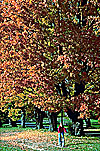 |
Fall
Foliage – Bucks County
One of the best places to see fall foliage is
in Bucks County, PA. Just an hour’s drive from Philadelphia, the
area is sprawling with magnificent trees, rolling hills and lush
landscapes. |
 |
Fall
Foliage – Bucks County
One of the best places to see fall foliage is
in Bucks County, PA. Just an hour’s drive from Philadelphia, the
area is sprawling with magnificent trees, rolling hills and lush
landscapes.
|
 |
Fall
Foliage – Bucks County
One of the best places to see fall foliage is
in Bucks County, PA. Just an hour’s drive from Philadelphia, the
area is sprawling with magnificent trees, rolling hills and lush
landscapes.
|
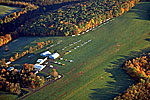 |
Van
Sant Airport – Erwinna, PA
This small airport in Erwinna, PA, offers
glider, aerobatic and bi-plane rides of varying lengths in an
assortment of aircrafts.
|
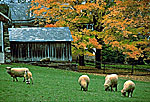 |
Stover-Myers
Mill
In 1855, this water-powered
gristmill/sawmill, located in Pipersville, PA, was powered by steam.
Tours of the mill are provided with reservations only.
.
|
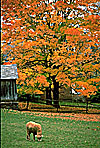 |
Stover-Myers
Mill
In 1855, this water-powered
gristmill/sawmill, located in Pipersville, PA, was powered by steam.
Tours of the mill are provided with reservations only.
|
 |
Lake
Nockamixon – Bucks County, PA
Although swimming is not permitted in Lake
Nockamixon, adventure seekers can partake in fishing, boating and
canoeing expeditions in the 1,450-acre body of water located in
Nockamixon State Park.
|
 |
Lake
Nockamixon – Bucks County, PA
Although swimming is not permitted in Lake
Nockamixon, adventure seekers can partake in fishing, boating and
canoeing expeditions in the 1,450-acre body of water located in
Nockamixon State Park.
|
SPECIAL EVENTS
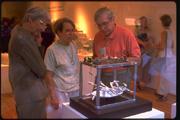
|
FIRST FRIDAY
The
first Friday of every month, the member organizations of the Old City
Arts Association hold a community-wide open house. Art lovers fill the
many galleries, shops, theaters and restaurants in this fascinating
neighborhood on the northeastern edge of center city. Casual browsers
as well as serious buyers enjoy the festive atmosphere of First Friday
openings.
|
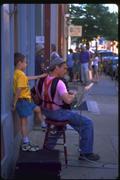 |
First
Friday Philadelphia (exterior)
The
many galleries and shops of Old City unveil new exhibitions on the
first Friday of every month. Festivities spill out onto the sidewalks,
where musicians and performance artists entertain the crowds of
"First Friday" regulars and newcomers. Restaurants abound,
from the casual to the serious. This neighborhood-wide open house
extends along Second and Third Streets, from Market to Race.
|
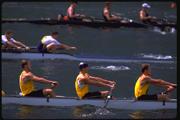 |
Sunoco’s
Dad Vail Regatta
Thousands
of student athletes and visitors arrive in Philadelphia each Spring
for Sunoco’s Dad Vail Regatta. The Schuylkill River provides an
idyllic setting for this event.
|
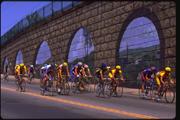 |
U.S. Pro Cycling Championship
This
156-mile bike race attracts top cyclists from around the world, who
speed around the River Drives and labor up the 300-foot-high
"wall" in Manayunk. Two weeks of celebration lead up to the
First Union U.S. Pro Cycling Championship and festivities continue
through the day of the race.
|
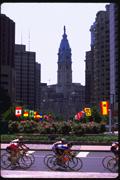 |
Pro Cycling Championship
Hundreds
of professional cyclists peddle through the streets of Philadelphia
each year during the First Union U.S. Pro Cycling Championship.
Festivities surrounding the race include a Victorian Main Street
Stroll in Manayunk, thousands of cheering onlookers, and a special
race up the infamous 300-foot-high "wall" the night before
the main event. |
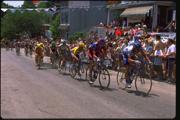 |
Pro Cycling Championship
Spectators
are invited to come and watch as many of the world’s top cyclists
race through Philadelphia in the First Union U.S. Pro Cycling
Championship. The row houses of Manayunk provide a charming backdrop
for much of the race, as fans cheer on their favorite teams and enjoy
the city-wide excitement.
Photo
credit: Photo by R. Kennedy © 1999 by Greater Philadelphia Tourism
Marketing Corporation.
|
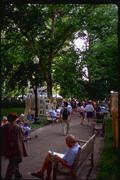 |
Rittenhouse
Square Fine Arts Annual
The
gracious park at 18th and Walnut Streets becomes an outdoor
gallery each year, when over a hundred local artists exhibit and sell
their work the Rittenhouse Square Fine Arts Annual. Painters,
sculptors and printmakers line the paths of the square with art of all
types. The tradition began in 1931, making this the oldest and largest
juried, outdoor art show in America.
|
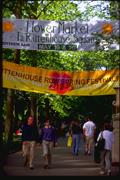 |
Rittenhouse
Row Spring Festival
During
the Rittenhouse Row Spring Festival, the many restaurants, shops,
spas, salons and cultural institutions of Rittenhouse Row provide
outdoor dining and entertainment. People of all ages enjoy the
activities available in historic Rittenhouse Square Park and along
Walnut Street, between Broad and 19th Street.
|
 |
Sand
Sculpture at Liberty Place
The
Vitetta Group Sand Sculpture at Liberty Place (a shopping mall in the
heart of downtown Philadelphia) was one of the artworks created as
part of the 1999 Sunoco Welcome America! Festival, which culminated on
July 4th. These are not your average sandcastles. Looming
high above visitors’ heads and crafted with breathtaking detail,
these sculptures celebrate Philadelphia’s historical past and
exciting present. In this detail, one can see chimpanzees from the new
Primate House at the Philadelphia Zoo.
Photo
credit: Photo by George Widman © 1999 by Greater Philadelphia Tourism
Marketing Corporation.
|
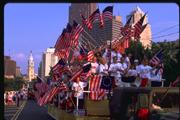 |
"Philadelphia,
the Place that Loves You Back" Fourth of July Parade (marchers)
Happy
Birthday America! Independence Day is always cause for an immense
celebration in Philadelphia, the nation’s birthplace. The
"Philadelphia, the Place that Loves You Back" Fourth of July
Parade winds through the city’s streets, dazzling onlookers with a
spectacle of red white and blue. Patriotic tunes are provided by a
variety of marching bands, including the city’s inimitable Mummers.
|
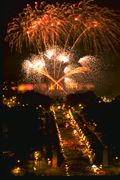 |
Fourth
of July Fireworks
Fireworks
blazing over the Philadelphia Museum of Art are a July 4th
tradition in Philadelphia. Timed perfectly with exhilarating live
music, the fireworks paint the skies over the Benjamin Franklin
Parkway. Thousands of residents and visitors come out for the most
patriotic party in America.
Photo
credit: Photo by George Widman © 1999 by Greater Philadelphia Tourism
Marketing Corporation.
|
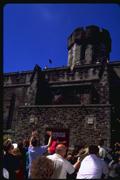 |
Bastille
Day, Eastern State Penitentiary
Eastern
State Penitentiary hosts Bastille Day to commemorate the storming of
the Bastille by French revolutionaries. This historic, 11-acre prison
in the Fairmount section of Philadelphia is also the site of art
exhibits, theater performances and other special events.
Photo
credit: Photo by Liz Wuillermin © 1999 by Greater Philadelphia
Tourism Marketing Corporation.
|
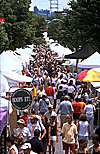 |
Manayunk
Art Festival
Visitors to the tri-state area’s largest
outdoor juried arts and crafts festival stroll along historic Main
Street in Manayunk, Philadelphia in search of unique wares created by
professional artists from around the world.
|
 |
Manayunk
Arts Festival
There’s plenty of food available at the
Manayunk Arts Festival, the tri-state area’s largest outdoor juried
arts and crafts festival along historic Main Street.
|
BACK TO TOP
All other photos not stated
under pictures are
Credited
by:
Photo by B. Krist © 2000 by Greater Philadelphia Tourism Marketing Corporation.
THIS
SITE IS UPDATED AND MAINTAINED DAILY BY ME~ CAROLANN SIRCHIE-2009.
|


 During the
Revolutionary war George Washington stayed at the
During the
Revolutionary war George Washington stayed at the 






























































































































